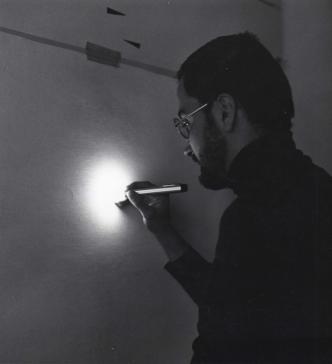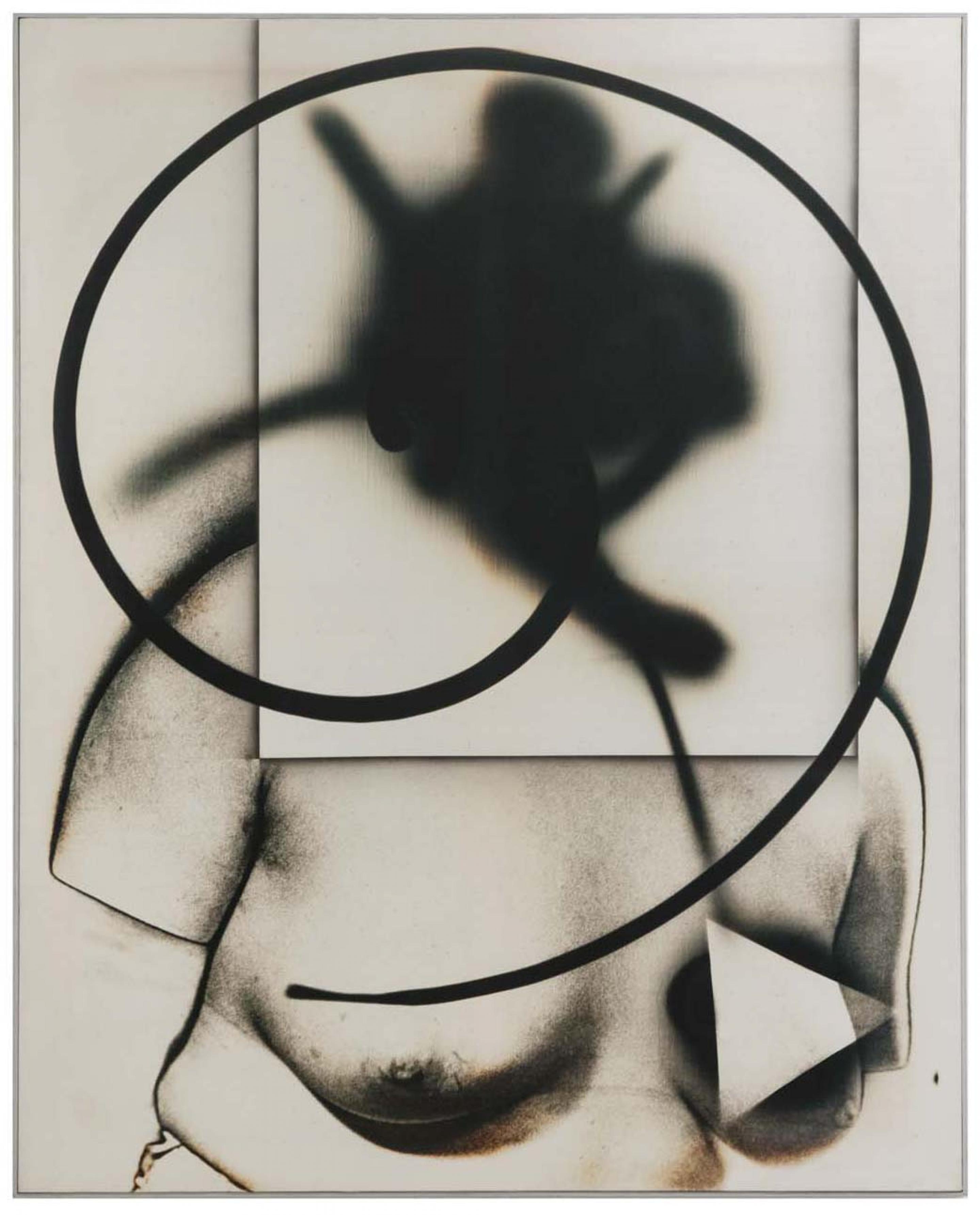BrunoDI BELLO
About
Bruno Di Bello began his activity by investigating into the potential decomposition of the image, which he practised through photography.
The artist’s favourite medium is photosensitive canvas on which the image is captured, decomposed, analysed and then recomposed before the viewer’s eyes.
Over the years he has experimented with the use of light directly “writing” on the photographic canvas, since the end of the Eighties, he has concentrated on studying new technologies, particularly digital photography, which has made him a specialist in the field of techniques of computer-created and processed images.
Bruno Di Bello was born in Torre del Greco in 1938. After studying at the Naples Academy of Fine Arts, he began to exhibit his work.
Together with Biasi, Del Pezzo, Fergola, Luca and Persico, he founded Gruppo ’58. Among the merits of this young group was to establish direct contact with contemporary art events in Milan, particularly through the magazine "Documento Sud", the ideal equivalent of "Azimuth".
After the group’s first exhibitions at the Galleria San Carlo and the Galleria Minerva in Naples, in 1960 Di Bello held his first solo show at Galleria 2000 in Bologna.
In 1965 he began to include photography in his work, and in 1966 held his first solo show at Lucio Amelio’s Modern Art Agency. In 1967 he began to use light-sensitive canvas directly and relocated to Milan. The following year he exhibited with the Mec-Art group, theorised by Pierre Restany.
Di Bello investigated the possibilities of deconstructing images, studying the icons of the main figures of the historical avant-gardes and their artistic myths (Klee, Duchamp, Man Ray, Mondrian and the Russian constructivists), and from this developing the notion of art as a reflection on the history of modern art.
He exhibited for the first time in Milan at Galleria Franco Toselli in 1969, and in 1970 at Kuchels Gallery (Bochum), Wspòlczesna Gallery (Warsaw), Galleria Bertesca (Genoa) and at the Venice Biennial. 1971 marked his first collaboration with Studio Marconi: an installation consisting of twenty-six photographic canvases with the deconstruction of the entire alphabet.
It was exhibited again in 1974, ’76, ’78 and ’81. In the early Seventies his photographic canvases also began to include words and concepts whose deconstruction and reconstruction animate a game involving the loss and rediscovery of meaning. In 1974, he exhibited at the Art in Progress Gallery in Munich and at the Kunsthalle in Bern, in 1975 at the Müller Gallery (Stuttgart) and the ICC (Antwerp), in 1977 at the Galleria Lucio Amelio (Naples) and the Museum Boijmans Van Beuningen (Rotterdam). In 1978 his work was shown at the Galleria Rondanini (Rome), and in the summer of 1980 he produced a large work for the Festival of Spoleto.
Other works from the Seventies and Eighties were produced by drawing directly on photosensitive canvas with the beam of an electric torch. Also during the Eighties Di Bello experimented with a new way of using the photographic technique, juxtaposing human figures and objects between the light source and the canvas so that their shadows were cast on the latter. He then developed the photosensitive canvas with broad brush strokes of developer, as in Apollo and Dafne nel terremoto, made for the Terrae motus collection displayed by Lucio Amelio in 1987 and exhibited in Paris at the Grand Palais, and now part of the collection at the Royal Palace of Caserta.
In the Nineties, Di Bello began to study the new technologies, researching synthetic images, digital photography and new geometries visualised by computer. He showed his new work in 2003 at Marconi’s, in 2004 at the Galleria Plurima (Udine), in 2005 at Fondazione Morra (Naples), and in 2008 at the Galleria Elleni (Bergamo).
In 2010, the Marconi Foundation held a major retrospective of his work. The occasion was marked by a monograph, Bruno Di Bello – Antologia, published by Silvana Editoriale for the VAF-Stiftung, Frankfurt am Main and edited by Volker Feierabend with texts by Michele Bonuomo, Mario Costa, Marco Meneguzzo and Angela Tecce.
In 2011, he held a solo show at the Museu de Arte Contemporânea de Niterói (MAC) in Rio de Janeiro. The show had debuted at the Certosa Museum on Capri then moved to the Palace of Arts (PAN) in Naples. The three exhibitions were the result of an initiative by the Arteas association in Naples. In 2011, Di Bello held a keynote lecture at Milan Polytechnic during the course taught by Alberto Aschieri, and showed his Grande vetro 2 from 1975 at the exhibition of student works on the Polytechnic patio.
In November 2015 he held a solo exhibition at the Marconi Foundation, for which Bruno Corà wrote an introductory text. The following year an exhibition curated by Luca Panaro Là dove interviene il disegno-la fotografia took place at the Bottari Lattes-Turin Foundation. In 2016 he participated to Italia Pop. L’arte negli anni del boom, a group exhibition held at the Fondazione Magnani Rocca, Mamiano di Traversetolo.
Finally, in 2017 he inaugurated a solo show at the Archaeological Museum of Naples (MANN), comprised of three six-metre triptychs of fractal geometry, for which he used the same colours he had carefully analysed in the Pompeian frescoes conserved in the museum.
In 2018 Camera Pop. La fotografia nella Pop Art di Warhol, Schifano & Co., curated by Walter Guadagnini took place at Camera, Turin; in February 2019 Museo del Novecento in Milan acquires the work Lasciapassare El Lissitzky, 1970.
Bruno Di Bello died suddenly at the age of 81, on March 5, 2019.
The artist’s favourite medium is photosensitive canvas on which the image is captured, decomposed, analysed and then recomposed before the viewer’s eyes.
Over the years he has experimented with the use of light directly “writing” on the photographic canvas, since the end of the Eighties, he has concentrated on studying new technologies, particularly digital photography, which has made him a specialist in the field of techniques of computer-created and processed images.
Bruno Di Bello was born in Torre del Greco in 1938. After studying at the Naples Academy of Fine Arts, he began to exhibit his work.
Together with Biasi, Del Pezzo, Fergola, Luca and Persico, he founded Gruppo ’58. Among the merits of this young group was to establish direct contact with contemporary art events in Milan, particularly through the magazine "Documento Sud", the ideal equivalent of "Azimuth".
After the group’s first exhibitions at the Galleria San Carlo and the Galleria Minerva in Naples, in 1960 Di Bello held his first solo show at Galleria 2000 in Bologna.
In 1965 he began to include photography in his work, and in 1966 held his first solo show at Lucio Amelio’s Modern Art Agency. In 1967 he began to use light-sensitive canvas directly and relocated to Milan. The following year he exhibited with the Mec-Art group, theorised by Pierre Restany.
Di Bello investigated the possibilities of deconstructing images, studying the icons of the main figures of the historical avant-gardes and their artistic myths (Klee, Duchamp, Man Ray, Mondrian and the Russian constructivists), and from this developing the notion of art as a reflection on the history of modern art.
He exhibited for the first time in Milan at Galleria Franco Toselli in 1969, and in 1970 at Kuchels Gallery (Bochum), Wspòlczesna Gallery (Warsaw), Galleria Bertesca (Genoa) and at the Venice Biennial. 1971 marked his first collaboration with Studio Marconi: an installation consisting of twenty-six photographic canvases with the deconstruction of the entire alphabet.
It was exhibited again in 1974, ’76, ’78 and ’81. In the early Seventies his photographic canvases also began to include words and concepts whose deconstruction and reconstruction animate a game involving the loss and rediscovery of meaning. In 1974, he exhibited at the Art in Progress Gallery in Munich and at the Kunsthalle in Bern, in 1975 at the Müller Gallery (Stuttgart) and the ICC (Antwerp), in 1977 at the Galleria Lucio Amelio (Naples) and the Museum Boijmans Van Beuningen (Rotterdam). In 1978 his work was shown at the Galleria Rondanini (Rome), and in the summer of 1980 he produced a large work for the Festival of Spoleto.
Other works from the Seventies and Eighties were produced by drawing directly on photosensitive canvas with the beam of an electric torch. Also during the Eighties Di Bello experimented with a new way of using the photographic technique, juxtaposing human figures and objects between the light source and the canvas so that their shadows were cast on the latter. He then developed the photosensitive canvas with broad brush strokes of developer, as in Apollo and Dafne nel terremoto, made for the Terrae motus collection displayed by Lucio Amelio in 1987 and exhibited in Paris at the Grand Palais, and now part of the collection at the Royal Palace of Caserta.
In the Nineties, Di Bello began to study the new technologies, researching synthetic images, digital photography and new geometries visualised by computer. He showed his new work in 2003 at Marconi’s, in 2004 at the Galleria Plurima (Udine), in 2005 at Fondazione Morra (Naples), and in 2008 at the Galleria Elleni (Bergamo).
In 2010, the Marconi Foundation held a major retrospective of his work. The occasion was marked by a monograph, Bruno Di Bello – Antologia, published by Silvana Editoriale for the VAF-Stiftung, Frankfurt am Main and edited by Volker Feierabend with texts by Michele Bonuomo, Mario Costa, Marco Meneguzzo and Angela Tecce.
In 2011, he held a solo show at the Museu de Arte Contemporânea de Niterói (MAC) in Rio de Janeiro. The show had debuted at the Certosa Museum on Capri then moved to the Palace of Arts (PAN) in Naples. The three exhibitions were the result of an initiative by the Arteas association in Naples. In 2011, Di Bello held a keynote lecture at Milan Polytechnic during the course taught by Alberto Aschieri, and showed his Grande vetro 2 from 1975 at the exhibition of student works on the Polytechnic patio.
In November 2015 he held a solo exhibition at the Marconi Foundation, for which Bruno Corà wrote an introductory text. The following year an exhibition curated by Luca Panaro Là dove interviene il disegno-la fotografia took place at the Bottari Lattes-Turin Foundation. In 2016 he participated to Italia Pop. L’arte negli anni del boom, a group exhibition held at the Fondazione Magnani Rocca, Mamiano di Traversetolo.
Finally, in 2017 he inaugurated a solo show at the Archaeological Museum of Naples (MANN), comprised of three six-metre triptychs of fractal geometry, for which he used the same colours he had carefully analysed in the Pompeian frescoes conserved in the museum.
In 2018 Camera Pop. La fotografia nella Pop Art di Warhol, Schifano & Co., curated by Walter Guadagnini took place at Camera, Turin; in February 2019 Museo del Novecento in Milan acquires the work Lasciapassare El Lissitzky, 1970.
Bruno Di Bello died suddenly at the age of 81, on March 5, 2019.




















